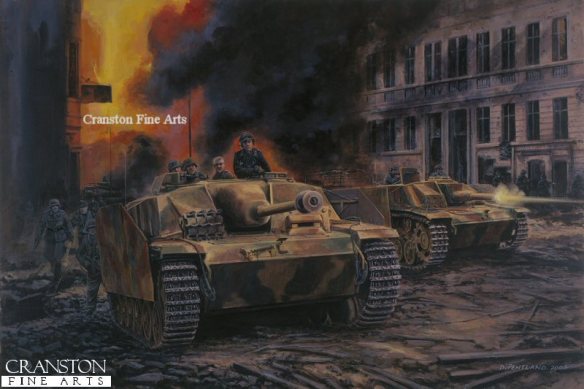
Escape to the Elbe, Berlin, 3rd May 1945 by David Pentland.
Following Hitlers death, the decision was taken by the officers and men of Sturmartillerie Brigade 249 to break out of the doomed capital. Shortly before midnight on the 3rd, what remained of the unit fought to the edge of the city at Spandau. By this time the brigade had been split into two elements, the first under Hauptmann Herbert Jaschke successfully punched their way out to the west. The second group was not so lucky, and its survivors fell into Soviet captivity.
No narrative of the Reich’s final days can be called typical. Let one stand nevertheless for many. The 249th Assault Gun Brigade was evacuated from West Prussia, reorganized and reinforced, and picked up new guns in Spandau, at the factory itself. It went into action in Berlin on April 27. In three days it destroyed 180 Soviet AFVs—at least by its own reckoning—and had only nine guns left. They fought in the heart of Berlin: on Frankfurter Allee, around the Technische Hochschule, across Alexanderplatz. One of the officers was hanged by an SS flying squad, presumably for “cowardice.” Another received the Knight’s Cross for valor.
On May 5, Hitler’s death was announced. The CO called his men together, and it was decided to break out toward the Elbe. In the darkness, the brigade lost contact. Half cut its way through to the Elbe. The other half, three guns, came under Russian fire. The lead vehicle took a direct hit. The next one got stuck. The third came to help, saw the second gun blown apart, and was itself disabled. Its crew escaped. The 249th had fought to the last gun and the last round. Adolf Hitler had long been aware the war was lost. Instead of a glorious final victory, he sought a heroic downfall, a Wagnerian Götterdammerung. What he achieved was in macrocosm the fate of this single small unit: downfall in chaos.